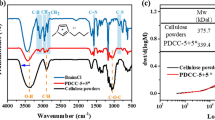Abstract
Rheological properties of microcrystalline and kraft cellulose dissolved in lithium chloride/N,N-dimethylacetamide solutions were characterized using an advanced rheometer. First, the effect of LiCl on the viscosity of DMAc (8%) at various temperatures was evaluated. Then the shear rheology of cellulose/DMAc/LiCl solutions was studied in a range of concentrations (0.25–2 wt%) and temperatures (25–80 °C). The solutions of kraft cellulose/LiCl/DMAc behave as non-Newtonian liquids and its viscosity is dependent on the shear rate. The Newtonian flow was recorded for the microcrystalline cellulose/LiCl/DMAc solutions. The viscosity values of these solutions were analyzed in detail for viscosity-concentration and viscosity-temperature. The viscosity of the solutions increased with the increase in solution concentration. The heightening of the solution temperature reduced the viscosity of the solutions. The activation energy of the dissolved kraft cellulose was calculated from the Arrhenius approximation within a concentration range of 0.25–2 wt%, and then compared with that of the microcrystalline cellulose.








Similar content being viewed by others
References
Cai J, Zhang LN, Zhou JP, Chen H, Jin HM (2004) Novel fibers prepared from cellulose in NaOH/urea aqueous solution. Macromol Rapid Commun 25:1558–1562
Heinze T, Dicke R, Koschella A, Kull AH, Klohr EA, Koch W (2000) Effective preparation of cellulose derivatives in a new simple cellulose solvent. Macromol Chem Phys 201:627–631
Kunze J, Fink HP (2005) Structural changes and activation of cellulose by caustic soda solution with urea. Macromol Symp 223:175–187
Rosenau T, Potthast A, Sixta H, Kosma P (2001) The chemistry of side reactions and byproduct formation in the system NMMO/cellulose. Prog Polym Sci 26:1763–1837
Kubisa P (2004) Application of ionic liquids as solvents for polymerization processes. Prog Polym Sci 29:3–12
Singh B, Sekhon SS (2005) Polymer electrolytes based on room temperature ionic liquid: 2,3-dimethyl-1-octylimidazolium triflate. J Phys Chem B 109:16539–16543
Huddleston JG, Visser AE, Reichert WM, Willauer HD, Broker GA, Rogers RD (2001) Characterization and comparison of hydrophilic and hydrophobic room temperature ionic liquids incorporating the imidazolium cation. Green Chem 3:156–164
Welton T (1999) Room-temperature ionic liquids. Solvents for synthesis and catalysis. Chem Rev 99:2071–2084
Holbrey JD, Seddon KR (1999) Ionic liquids. Clean Products Process 1:223–236
Swatloski RP, Spear SK, Holbrey JD, Rogers RD (2002) Dissolution of cellulose [correction of cellose] with ionic liquids. J Am Chem Soc 124:4974–4975
Zhu SD, Wu YX, Chen QM, Yu ZN, Wang CW, Jin SW et al (2006) Dissolution of cellulose with ionic liquids and its application: a mini review. Green Chem 8:325–327
Zhang H, Wu J, Zhang J, He JS (2005) 1-Allyl-3-methylimidazolium chloride room temperature ionic liquid: a new and powerful nonderivatizing solvent for cellulose. Macromolecules 38:8272–8277
El Hamdaoui L, El Moussaouiti M, Gmouh S (2016) Homogeneous esterification of cellulose in the mixture n-butylpyridinium chloride/dimethylsulfoxide. IJPS. doi:10.1155/2016/1756971
Kuang QL, Zhao JC, Niu YH, Zhang J, Wang ZG (2008) Cellulose in an ionic liquid: the rheological properties of the solutions spanning the dilute and semidilute regimes. J Phys Chem B 112:10234–10240
Horinaka J, Yasuda R, Takigawa T (2011) Entanglement properties of cellulose and amylose in an ionic liquid. J Polym Sci B: Polym Phys 49:961–965
Chen X, Zhang Y, Wang H, Wang S, Liang S, Colby R (2011) Solution rheology of cellulose in 1 butyl-3-methyl imidazolium chloride. J Rheol 55:485–494
Chen X, Zhang Y, Cheng L, Wang H (2009) Rheology of concentrated cellulose solutions in 1-butyl-3-methylimidazolium chloride. J Polym Environ 17:273–279
Gericke M, Schlufter K, Liebert T, Heinze T, Budtova T (2009) Rheological properties of cellulose/ionic liquid solutions: from dilute to concentrated states. Biomacromolecules 10:1188–1194
Collier JR, Watson JL, Collier BJ, Petrovan S (2009) Rheological properties of cellulose/ionic liquid solutions: from dilute to concentrated states rheology of 1-butyl-3-methylimidazolium chloride cellulose solutions, II. Solution character and preparation. J Appl Polym Sci 111:1019–1027
Sescousse R, Ries ME, Budtova T (2010) Viscosity of cellulose-imidazolium-based ionic liquid solutions. J Phys Chem B 114:7222–7228
Sammons RJ, Collier JR, Rials TG, Petrovan S (2008) Rheology of 1-butyl-3-methylimidazolium chloride cellulose solutions. I. Shear rheology. J Appl Polym Sci 110:1175–1181
Lv Yuxia et al (2012) Rheological properties of cellulose/ionic liquid/dimethylsulfoxide (DMSO) solutions. Polymer 53:2524–2531
Nobutake T, Hajime A, Daisuke T, Takayoshi M (2003) Differences in rheological properties of solutions of plant and bacterial cellulose in LiCl/N,N-dimethylacetamide. J Soc Rheol 31:119–130
Li L (2002) Thermal gelation of methylcellulose in water: scaling and thermoreversibility. Macromolecules 35:5990–5998
Bahlouli M, Bekkour K, Benchabane A, HemarY Nemdili A (2013) The effect of temperature on the rheological behavior of polyethylene oxide (PEO) solutions. Appl Rheol 23:62–69
Yang T, Yao Y, Lin Y, Wang B, Niu A, Wu D (2010) Rheological behavior of polyacrylonitrile in an ionic liquid solution, Textile Institute, Sichuan University, Chengdu, China. Iran Polym J 19:843–852
Rodriguez F (1989) Principles of polymer systems, 3rd edn. Hemisphere Publishing Corporation, New York
Krässig H (1996) Cellulose, polymer monographs, vol 11. Gordon and Breach Science Publishers, Amsterdam, pp 6–42
Peter K, Muhannad J, El Saleh F (2000) Influence of degree of polymerization on behavior of cellulose during homogenization and extrusion/spheronization. AAPS Pharm Sci 2:18–27. doi:10.1208/ps020321
Tatiana B, Patrick N (2015) Viscosity-temperature dependence and activation energy of cellulose solutions. NPPRJ 30:99–104
Author information
Authors and Affiliations
Corresponding author
Rights and permissions
About this article
Cite this article
El Hamdaoui, L., El Bouchti, M. & El Moussaouiti, M. Comparison of rheological properties of kraft and microcrystalline cellulose dissolved in lithium chloride/N,N-dimethylacetamide. Polym. Bull. 75, 769–779 (2018). https://doi.org/10.1007/s00289-017-2066-3
Received:
Revised:
Accepted:
Published:
Issue Date:
DOI: https://doi.org/10.1007/s00289-017-2066-3




